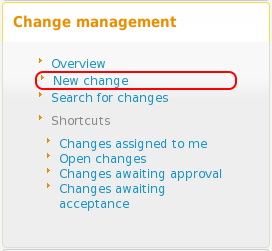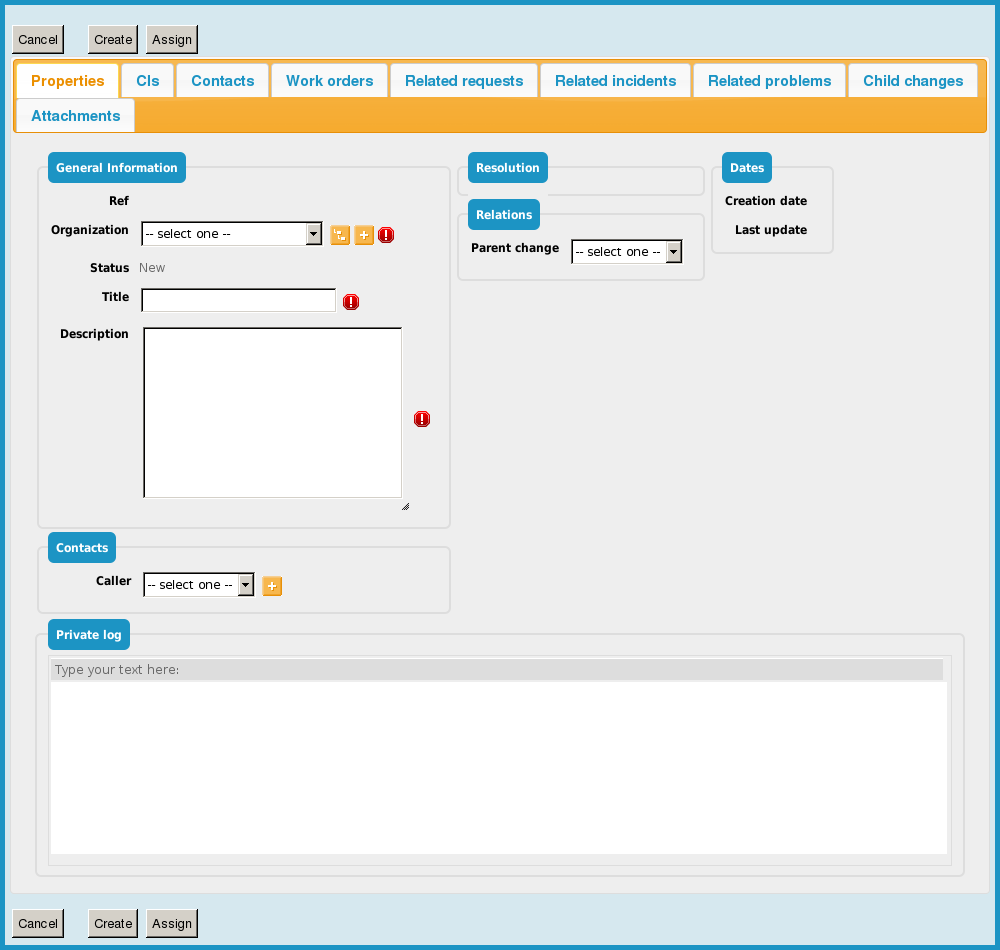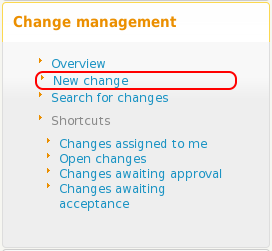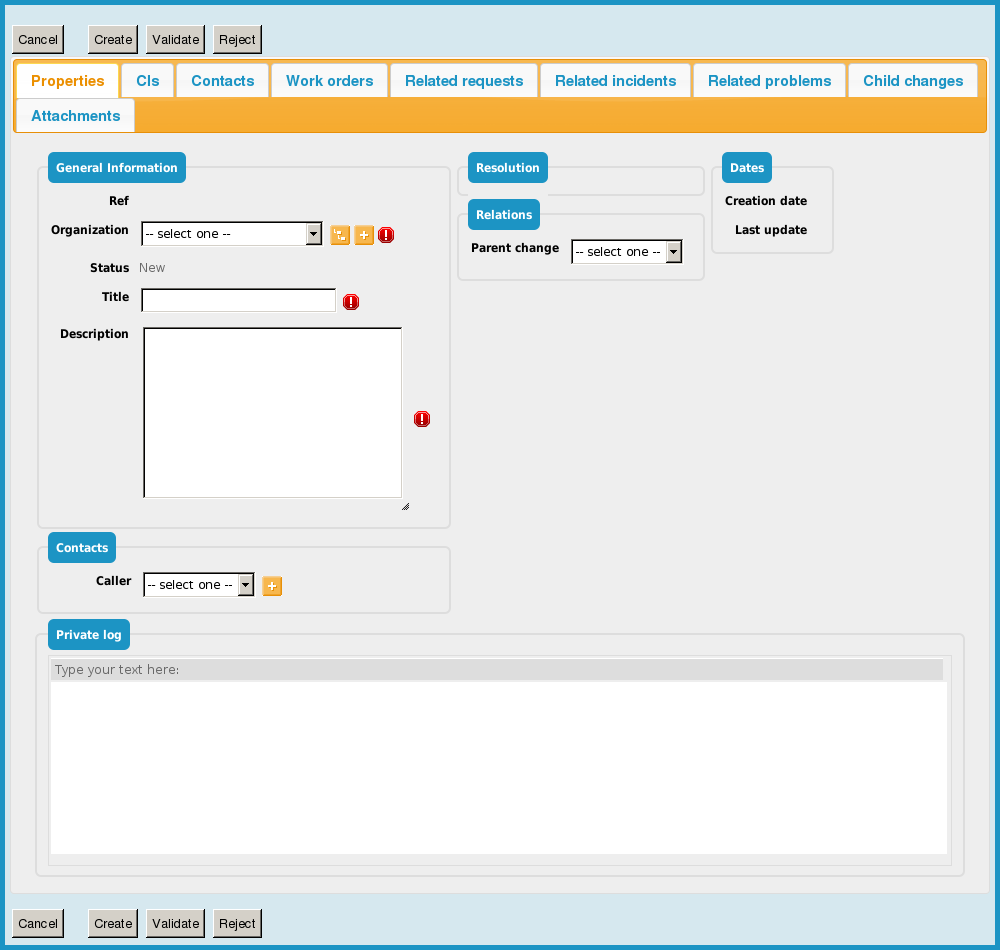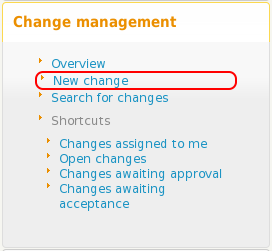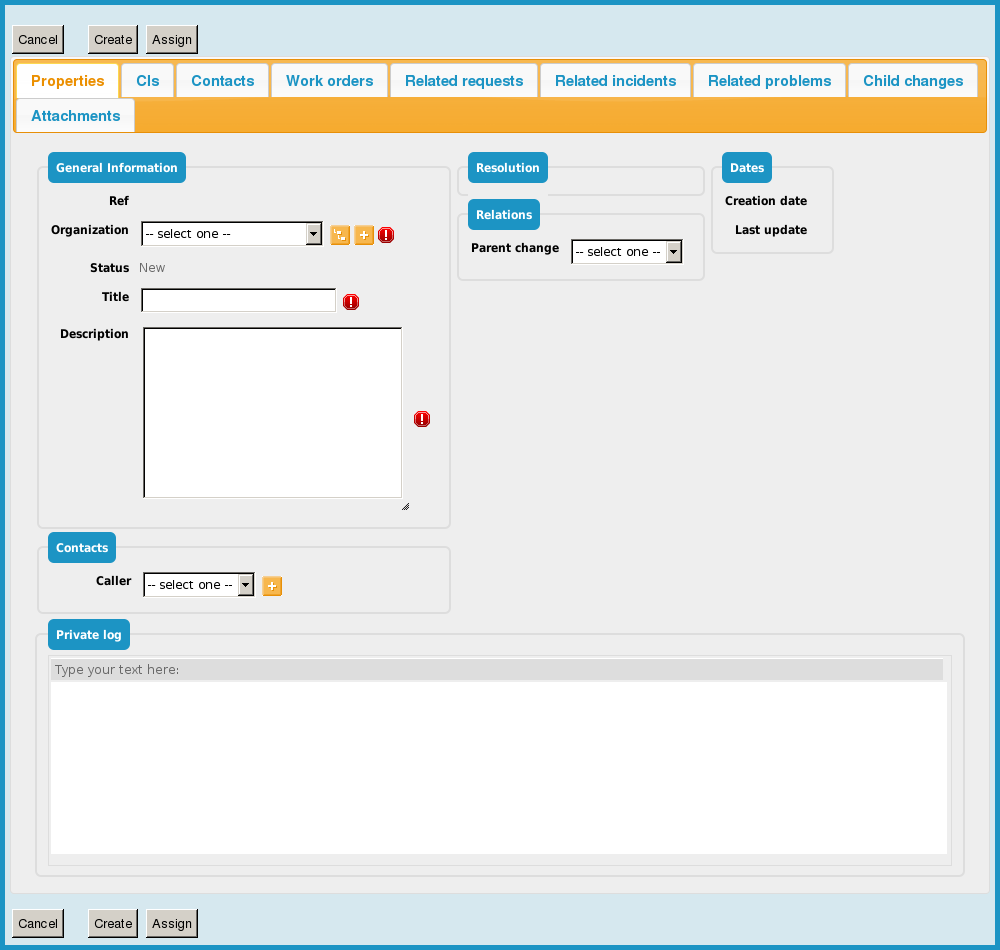Change Management ITIL Module
A change is used to document all the modifications that are planned in the IT:
-
Patch installations
-
System configuration changes
-
OS updates
-
Software installations
This way you can track all the modifications made within your IT. A lot of incidents are due to changes made to the IT environment. By documenting them, you can identify easily what changes had been made when an incident occurs and restore the service more quickly.
Moreover, this change management module allows you to analyze automatically the impact of the changes on the infrastructure and the application solutions. IT engineers can then better control the unavailability of the critical services in the enterprise, and improve customer satisfaction.
The changes are managed by the people having the following profiles:
-
Change implementors plan and implement the changes
-
Change supervisors follow up with the changes
-
Change managers approve the changes
When installing iTop, you have the choice between two differents modules for documenting changes. The module described here has been designed to implement ITIL V3 change management with three types of changes:
-
Routine changes
-
Normal changes
-
Emergency changes
The differences between those three types of changes rely in their respective workflows.
Emergency Changes
![]() An ITIL emergency change
is the highest priority change that can be defined in an
organization. Emergency changes are defined as changes that need to
be evaluated, assessed and either rejected or approved in a short
timeframe. Simply defining a change as an emergency does not
automatically entail the change should be implemented. The
Emergency Change Advisory Board (ECAB) will assess the change and
provide advice to the delegated person responsible for approving or
rejecting emergency changes.
An ITIL emergency change
is the highest priority change that can be defined in an
organization. Emergency changes are defined as changes that need to
be evaluated, assessed and either rejected or approved in a short
timeframe. Simply defining a change as an emergency does not
automatically entail the change should be implemented. The
Emergency Change Advisory Board (ECAB) will assess the change and
provide advice to the delegated person responsible for approving or
rejecting emergency changes.
Emergency Change Properties
| Name | Type | Mandatory? |
|---|---|---|
| Ref | Alphanumeric string | Yes |
| Organization | Foreign key to a(n) Organization | Yes |
| Status | Possible values: Approved, Assigned, Closed, Implemented, Monitored, New, Not approved, Planned and scheduled, Rejected, Validated | No |
| Title | Alphanumeric string | Yes |
| Description | Multiline character string | Yes |
| Approval comment | Alphanumeric string | No |
| Caller | Foreign key to a(n) Person | No |
| Team | Foreign key to a(n) Team | No |
| Agent | Foreign key to a(n) Person | No |
| Supervisor team | Foreign key to a(n) Team | No |
| Supervisor | Foreign key to a(n) Person | No |
| Manager team | Foreign key to a(n) Team | No |
| Manager | Foreign key to a(n) Person | No |
| Reject reason | Alphanumeric string | No |
| Impact | Alphanumeric string | No |
| Outage | Possible values: No, Yes | Yes |
| Fallback plan | Multiline character string | No |
| Parent change | Foreign key to a(n) Change | No |
| Creation date | Date and time (year-month-day hh:mm:ss) | No |
| Start date | Date and time (year-month-day hh:mm:ss) | No |
| End date | Date and time (year-month-day hh:mm:ss) | No |
| Last update | Date and time (year-month-day hh:mm:ss) | No |
| Approval Date | Date and time (year-month-day hh:mm:ss) | No |
| Close date | Date and time (year-month-day hh:mm:ss) | No |
Tabs
| Tab | Description |
|---|---|
| CIs | All the configuration items impacted for this ticket |
| Contacts | All the contacts linked to this ticket |
| Work orders | All the work orders for this ticket |
| Related requests | All the user requests linked to this change |
| Related incidents | All the incidents linked to this change |
| Related problems | All the problems linked to this change |
| Child changes | All the sub changes linked to this change |
Creating a Emergency Change
Click on the “New change” menu:
Then select “Emergency Change” in the form below:
And click “Apply” to display the Emergency Change creation form:
Emergency Change Life Cycle
Emergency Change objects have the following life cycle:
Depending on the status of the object, the contraints on the properties vary as shown on the table below:
| New | Assigned | Planned and scheduled | Approved | Not approved | Implemented | Monitored | Closed | |
|---|---|---|---|---|---|---|---|---|
| Ref | R/O | R/O | R/O | R/O | R/O | R/O | R/O | R/O |
| Organization | R/O | R/O | R/O | R/O | R/O | R/O | ||
| Status | R/O | R/O | R/O | R/O | R/O | R/O | R/O | R/O |
| Title | M | M | M | M | M | R/O | R/O | R/O |
| Description | R/O | R/O | R/O | R/O | R/O | R/O | R/O | |
| Approval comment | H | H | H | M | H | R/O | R/O | R/O |
| Caller | R/O | R/O | ||||||
| Team | H | M | M | M | M | M | R/O | R/O |
| Agent | H | M | M | M | M | M | R/O | R/O |
| Supervisor team | H | M | M | R/O | R/O | R/O | R/O | R/O |
| Supervisor | H | M | M | R/O | R/O | R/O | R/O | R/O |
| Manager team | H | M | M | R/O | R/O | R/O | R/O | R/O |
| Manager | H | M | M | R/O | R/O | R/O | R/O | R/O |
| Reject reason | H | R/O | R/O | R/O | M | R/O | R/O | R/O |
| Impact | H | H | M | R/O | R/O | R/O | R/O | R/O |
| Outage | H | H | M | R/O | M | R/O | R/O | R/O |
| Fallback plan | H | H | M | M | M | M | R/O | R/O |
| Parent change | R/O | R/O | ||||||
| Creation date | R/O | R/O | R/O | R/O | R/O | R/O | R/O | R/O |
| Start date | H | H | M | M | M | R/O | R/O | R/O |
| End date | H | H | M | M | M | M | R/O | R/O |
| Last update | R/O | R/O | R/O | R/O | R/O | R/O | R/O | R/O |
| Approval Date | H | H | H | M | H | R/O | R/O | R/O |
| Close date | H | H | H | H | H | H | H | R/O |
-
H: hidden
-
R/O: read-only
-
M: mandatory
Normal Change
![]() An ITIL normal change
refers to changes that must follow the complete change management
process. By definition a normal change will proceed through all
steps of the change management process and will eventually be
reviewed by the Change Advisory Board (CAB). The CAB will provide
advice regarding the change to the person who is deemed responsible
to approve or reject normal changes.
An ITIL normal change
refers to changes that must follow the complete change management
process. By definition a normal change will proceed through all
steps of the change management process and will eventually be
reviewed by the Change Advisory Board (CAB). The CAB will provide
advice regarding the change to the person who is deemed responsible
to approve or reject normal changes.
Normal Change Properties
| Name | Type | Mandatory? |
|---|---|---|
| Ref | Alphanumeric string | Yes |
| Organization | Foreign key to a(n) Organization | Yes |
| Status | Possible values: Approved, Assigned, Closed, Implemented, Monitored, New, Not approved, Planned and scheduled, Rejected, Validated | No |
| Title | Alphanumeric string | Yes |
| Description | Multiline character string | Yes |
| Approval comment | Alphanumeric string | No |
| Acceptance comment | Multiline character string | No |
| Caller | Foreign key to a(n) Person | No |
| Team | Foreign key to a(n) Team | No |
| Agent | Foreign key to a(n) Person | No |
| Supervisor team | Foreign key to a(n) Team | No |
| Supervisor | Foreign key to a(n) Person | No |
| Manager team | Foreign key to a(n) Team | No |
| Manager | Foreign key to a(n) Person | No |
| Reject reason | Alphanumeric string | No |
| Impact | Alphanumeric string | No |
| Outage | Possible values: No, Yes | Yes |
| Fallback plan | Multiline character string | No |
| Parent change | Foreign key to a(n) Change | No |
| Creation date | Date and time (year-month-day hh:mm:ss) | No |
| Start date | Date and time (year-month-day hh:mm:ss) | No |
| End date | Date and time (year-month-day hh:mm:ss) | No |
| Last update | Date and time (year-month-day hh:mm:ss) | No |
| Approval Date | Date and time (year-month-day hh:mm:ss) | No |
| Acceptance date | Date and time (year-month-day hh:mm:ss) | No |
| Close date | Date and time (year-month-day hh:mm:ss) | No |
Tabs
| Tab | Description |
|---|---|
| CIs | All the configuration items impacted for this ticket |
| Contacts | All the contacts linked to this ticket |
| Work orders | All the work orders for this ticket |
| Related requests | All the user requests linked to this change |
| Related incidents | All the incidents linked to this change |
| Related problems | All the problems linked to this change |
| Child changes | All the sub changes linked to this change |
Creating a Normal Change
Click on the “New change” menu:
Then select “Normal Change” in the form below:
And click “Apply” to display the Normal Change creation form:
Normal Change Life Cycle
Normal Change objects have the following life cycle:
Depending on the status of the object, the contraints on the properties vary as shown on the table below:
| New | Validated | Rejected | Assigned | Planned and scheduled | Approved | Not approved | Implemented | Monitored | Closed | |
|---|---|---|---|---|---|---|---|---|---|---|
| Ref | R/O | R/O | R/O | R/O | R/O | R/O | R/O | R/O | R/O | R/O |
| Organization | R/O | R/O | R/O | R/O | R/O | R/O | ||||
| Status | R/O | R/O | R/O | R/O | R/O | R/O | R/O | R/O | R/O | R/O |
| Title | M | M | M | M | M | M | M | R/O | R/O | R/O |
| Description | R/O | R/O | R/O | R/O | R/O | R/O | R/O | R/O | ||
| Approval comment | H | H | H | H | H | M | H | R/O | R/O | R/O |
| Acceptance comment | H | M | H | R/O | R/O | R/O | R/O | R/O | R/O | |
| Caller | R/O | R/O | ||||||||
| Team | H | M | R/O | R/O | ||||||
| Agent | H | H | H | M | M | M | M | M | R/O | R/O |
| Supervisor team | H | M | H | M | M | R/O | R/O | R/O | R/O | R/O |
| Supervisor | H | H | H | M | M | R/O | R/O | R/O | R/O | R/O |
| Manager team | H | M | H | M | M | R/O | R/O | R/O | R/O | R/O |
| Manager | H | H | H | M | M | R/O | R/O | R/O | R/O | R/O |
| Reject reason | H | R/O | M | R/O | R/O | R/O | M | R/O | R/O | R/O |
| Impact | H | H | H | H | M | R/O | R/O | R/O | R/O | R/O |
| Outage | H | H | H | H | M | R/O | M | R/O | R/O | R/O |
| Fallback plan | H | H | H | H | M | M | M | M | R/O | R/O |
| Parent change | R/O | R/O | ||||||||
| Creation date | R/O | R/O | R/O | R/O | R/O | R/O | R/O | R/O | R/O | R/O |
| Start date | H | H | H | H | M | M | M | R/O | R/O | R/O |
| End date | H | H | H | H | M | M | M | M | R/O | R/O |
| Last update | R/O | R/O | R/O | R/O | R/O | R/O | R/O | R/O | R/O | R/O |
| Approval Date | H | H | H | H | H | M | H | R/O | R/O | R/O |
| Acceptance date | H | M | H | R/O | R/O | R/O | R/O | R/O | R/O | |
| Close date | H | H | H | H | H | H | H | H | H | R/O |
-
H: hidden
-
R/O: read-only
-
M: mandatory
Routine Change
![]() An ITIL routine
(standard) change quite simply refers to pre-approved changes.
Pre-approved changes can be defined for a variety of tasks, but
they will typically be low risk, low effort changes that have a low
or known cost.
An ITIL routine
(standard) change quite simply refers to pre-approved changes.
Pre-approved changes can be defined for a variety of tasks, but
they will typically be low risk, low effort changes that have a low
or known cost.
Routine Change Properties
| Name | Type | Mandatory? |
|---|---|---|
| Ref | Alphanumeric string | Yes |
| Organization | Foreign key to a(n) Organization | Yes |
| Status | Possible values: Approved, Assigned, Closed, Implemented, Monitored, New, Not approved, Planned and scheduled, Rejected, Validated | No |
| Title | Alphanumeric string | Yes |
| Description | Multiline character string | Yes |
| Caller | Foreign key to a(n) Person | No |
| Team | Foreign key to a(n) Team | No |
| Agent | Foreign key to a(n) Person | No |
| Supervisor team | Foreign key to a(n) Team | No |
| Supervisor | Foreign key to a(n) Person | No |
| Manager team | Foreign key to a(n) Team | No |
| Manager | Foreign key to a(n) Person | No |
| Reject reason | Alphanumeric string | No |
| Impact | Alphanumeric string | No |
| Outage | Possible values: No, Yes | Yes |
| Fallback plan | Multiline character string | No |
| Parent change | Foreign key to a(n) Change | No |
| Creation date | Date and time (year-month-day hh:mm:ss) | No |
| Start date | Date and time (year-month-day hh:mm:ss) | No |
| End date | Date and time (year-month-day hh:mm:ss) | No |
| Last update | Date and time (year-month-day hh:mm:ss) | No |
| Close date | Date and time (year-month-day hh:mm:ss) | No |
Tabs
| Tab | Description |
|---|---|
| CIs | All the configuration items impacted for this ticket |
| Contacts | All the contacts linked to this ticket |
| Work orders | All the work orders for this ticket |
| Related requests | All the user requests linked to this change |
| Related incidents | All the incidents linked to this change |
| Related problems | All the problems linked to this change |
| Child changes | All the sub changes linked to this change |
Creating a Routine Change
Click on the “New change” menu:
Then select “Routine Change” in the form below:
And click “Apply” to display the Routine Change creation form:
Routine Change Life Cycle
Routine Change objects have the following life cycle:
Depending on the status of the object, the contraints on the properties vary as shown on the table below:
| New | Assigned | Planned and scheduled | Implemented | Monitored | Closed | |
|---|---|---|---|---|---|---|
| Ref | R/O | R/O | R/O | R/O | R/O | R/O |
| Organization | R/O | R/O | R/O | R/O | ||
| Status | R/O | R/O | R/O | R/O | R/O | R/O |
| Title | M | M | M | R/O | R/O | R/O |
| Description | R/O | R/O | R/O | R/O | R/O | |
| Caller | R/O | R/O | ||||
| Team | H | M | M | M | R/O | R/O |
| Agent | H | M | M | M | R/O | R/O |
| Supervisor team | H | M | M | R/O | R/O | R/O |
| Supervisor | H | M | M | R/O | R/O | R/O |
| Manager team | H | M | M | R/O | R/O | R/O |
| Manager | H | M | M | R/O | R/O | R/O |
| Reject reason | H | R/O | R/O | R/O | R/O | R/O |
| Impact | H | H | M | R/O | R/O | R/O |
| Outage | H | H | M | R/O | R/O | R/O |
| Fallback plan | H | H | M | M | R/O | R/O |
| Parent change | R/O | R/O | ||||
| Creation date | R/O | R/O | R/O | R/O | R/O | R/O |
| Start date | H | H | M | R/O | R/O | R/O |
| End date | H | H | M | M | R/O | R/O |
| Last update | R/O | R/O | R/O | R/O | R/O | R/O |
| Close date | H | H | H | H | H | R/O |
-
H: hidden
-
R/O: read-only
-
M: mandatory
Assigning a user request to a team and agent
The list of teams to which you can assign a change is defined by the delivery model of the corresponding organization. When creating a change, the agent has to select the customer organization, then the list of teams is strictly limited to the teams defined for this customer. If a team is missing, the delivery model of the customer must be updated to reflect this need. See More about Delivery model for more information
Managing Private Log
A change ticket only have a private log to document all the activities and communications related to it. This one is not visible on the end user portal.
Managing impacted CIs and Contacts
This section is similar to the one of the Helpdesk module. Please refer to it

